A dynamic interplay between chitin synthase and the proteins Expansion/Rebuf reveals that chitin polymerisation and translocation are uncoupled in Drosophila
- PMID: 36689563
- PMCID: PMC9894549
- DOI: 10.1371/journal.pbio.3001978
A dynamic interplay between chitin synthase and the proteins Expansion/Rebuf reveals that chitin polymerisation and translocation are uncoupled in Drosophila
Abstract
Chitin is a highly abundant polymer in nature and a principal component of apical extracellular matrices in insects. In addition, chitin has proved to be an excellent biomaterial with multiple applications. In spite of its importance, the molecular mechanisms of chitin biosynthesis and chitin structural diversity are not fully elucidated yet. To investigate these issues, we use Drosophila as a model. We previously showed that chitin deposition in ectodermal tissues requires the concomitant activities of the chitin synthase enzyme Kkv and the functionally interchangeable proteins Exp and Reb. Exp/Reb are conserved proteins, but their mechanism of activity during chitin deposition has not been elucidated yet. Here, we carry out a cellular and molecular analysis of chitin deposition, and we show that chitin polymerisation and chitin translocation to the extracellular space are uncoupled. We find that Kkv activity in chitin translocation, but not in polymerisation, requires the activity of Exp/Reb, and in particular of its conserved Nα-MH2 domain. The activity of Kkv in chitin polymerisation and translocation correlate with Kkv subcellular localisation, and in absence of Kkv-mediated extracellular chitin deposition, chitin accumulates intracellularly as membrane-less punctae. Unexpectedly, we find that although Kkv and Exp/Reb display largely complementary patterns at the apical domain, Exp/Reb activity nonetheless regulates the topological distribution of Kkv at the apical membrane. We propose a model in which Exp/Reb regulate the organisation of Kkv complexes at the apical membrane, which, in turn, regulates the function of Kkv in extracellular chitin translocation.
Copyright: © 2023 De Giorgio et al. This is an open access article distributed under the terms of the Creative Commons Attribution License, which permits unrestricted use, distribution, and reproduction in any medium, provided the original author and source are credited.
Conflict of interest statement
The authors have declared that no competing interests exist.
Figures
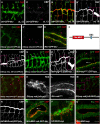
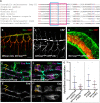
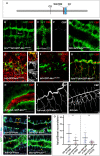
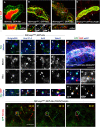

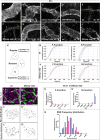
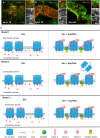
Similar articles
-
Deciphering the genetic programme triggering timely and spatially-regulated chitin deposition.PLoS Genet. 2015 Jan 24;11(1):e1004939. doi: 10.1371/journal.pgen.1004939. eCollection 2015 Jan. PLoS Genet. 2015. PMID: 25617778 Free PMC article.
-
Genome-wide in vitro and in vivo RNAi screens reveal Fer3 to be an important regulator of kkv transcription in Drosophila.Insect Sci. 2022 Jun;29(3):614-630. doi: 10.1111/1744-7917.12954. Epub 2021 Dec 14. Insect Sci. 2022. PMID: 34351065
-
SERCA interacts with chitin synthase and participates in cuticular chitin biogenesis in Drosophila.Insect Biochem Mol Biol. 2022 Jun;145:103783. doi: 10.1016/j.ibmb.2022.103783. Epub 2022 May 5. Insect Biochem Mol Biol. 2022. PMID: 35525402
-
Insect chitin synthases: a review.J Comp Physiol B. 2006 Jan;176(1):1-15. doi: 10.1007/s00360-005-0005-3. Epub 2005 Aug 2. J Comp Physiol B. 2006. PMID: 16075270 Review.
-
Advances in understanding insect chitin biosynthesis.Insect Biochem Mol Biol. 2024 Jan;164:104058. doi: 10.1016/j.ibmb.2023.104058. Epub 2023 Dec 9. Insect Biochem Mol Biol. 2024. PMID: 38072083 Review.
Cited by
-
Apical cell expansion maintained by Dusky-like establishes a scaffold for corneal lens morphogenesis.Sci Adv. 2024 Aug 23;10(34):eado4167. doi: 10.1126/sciadv.ado4167. Epub 2024 Aug 21. Sci Adv. 2024. PMID: 39167639 Free PMC article.
-
Identification and Functional Insights of Knickkopf Genes in the Larval Cuticle of Leptinotarsa decemlineata.Insects. 2024 Aug 19;15(8):623. doi: 10.3390/insects15080623. Insects. 2024. PMID: 39194827 Free PMC article.
-
Live Detection of Intracellular Chitin in Butterfly Wing Epithelial Cells In Vivo Using Fluorescent Brightener 28: Implications for the Development of Scales and Color Patterns.Insects. 2023 Sep 8;14(9):753. doi: 10.3390/insects14090753. Insects. 2023. PMID: 37754721 Free PMC article.
-
Chitin Synthase Is Required for Cuticle Formation and Molting in the Chinese Mitten Crab Eriocheir sinensis.Int J Mol Sci. 2025 Mar 6;26(5):2358. doi: 10.3390/ijms26052358. Int J Mol Sci. 2025. PMID: 40076977 Free PMC article.
-
Investigation on Dynamic and Static Modulus and Creep of Bio-Based Polyurethane-Modified Asphalt Mixture.Polymers (Basel). 2025 Jan 28;17(3):359. doi: 10.3390/polym17030359. Polymers (Basel). 2025. PMID: 39940561 Free PMC article.
References
-
- Zhao X, Zhang J, Zhu KY. Chito-Protein Matrices in Arthropod Exoskeletons and Peritrophic Matrices. In: Cohen E, Merzendorfer H. editors. Extracellular Sugar-Based Biopolymers Matrices Biologically-Inspired Systems. 12. Cham: Springer; 2019.
Publication types
MeSH terms
Substances
LinkOut - more resources
Full Text Sources
Molecular Biology Databases

